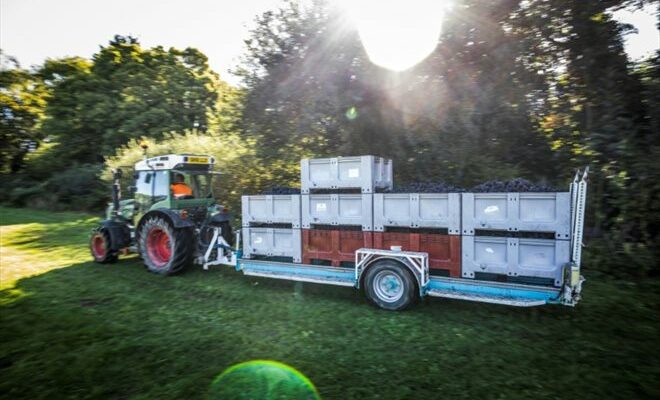Crates of grapes are transported after harvest at the Gusbourne Estate, Appledore, near Ashford, United Kingdom, September 28, 2022 (AFP/Archives/Ben Stansall)
Is the future in English wines? With climate change, some regions of the world risk no longer being able to produce wine profitably, while others will be able to launch into a new wine-growing activity, details a study published Tuesday.
“Climate change is modifying the geography of wine, there will be winners and losers,” summarizes Cornelis van Leeuwen, professor of viticulture at Bordeaux Sciences Agro.
With researchers based in France (Bordeaux, Dijon) and Italy, he synthesized existing studies on the effects of climate change: increased heat and drought, or even changes in parasites and diseases.
The study, published in the journal Nature Reviews Earth & Environment, concludes that there is a “substantial” risk of loss of ability to produce wine profitably for current producing regions. Depending on the level of warming, 49 to 70% of regions would lose this ability.
“We can still make wine almost anywhere (we make it in tropical climates, in Tahiti, in India, etc.), but here we are looking at quality wine with economically profitable yields,” explains Cornelis van Leeuwen to AFP.
Conversely, 11 to 25% of regions where vines are already established could see their production improve, and new wine-growing regions could emerge at higher latitudes and altitudes. For example, in the south of Britain, where the culture is now embryonic.
As in other areas, the level of future warming will significantly change the situation.
If it remains below 2°C globally – the upper limit of the Paris agreement – most producing regions in Europe will retain their ability to produce, at the cost of adaptation measures.
On the other hand, “under more severe warming scenarios, most Mediterranean regions could become climatically unsuitable for wine production,” the study concludes.
Some 90% of traditional wine-growing regions in coastal and lowland areas of Spain, Italy and Greece would be threatened with disappearance by the end of the century. Elsewhere in the world, Southern California could also face the same fate.
On the other hand, “France is not the most exposed country”, notes Cornelis van Leeuwen.
Some producing regions will need to adapt, for example by using grape varieties that can withstand higher temperatures and drought such as Carignan, Grenache, Mourvèdre (in red) or Chenin and Xynesteri (in white).
“We warn against the deployment of irrigation: it is a + maladaptation +”, adds Cornelis van Leeuwen. “Irrigated vines are more vulnerable to drought if there is a lack of water” and water “is a limited resource and it is madness to grant it to the vines, which can very well cope with a crop dry,” he emphasizes.
© 2024 AFP
Did you like this article ? Share it with your friends using the buttons below.




